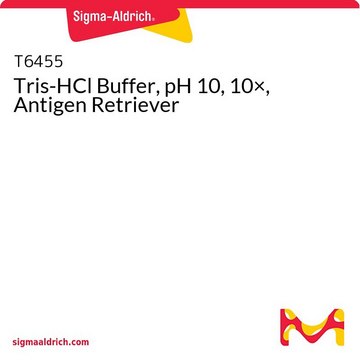T5941
Trizma® hydrochloride
BioPerformance Certified, suitable for cell culture, ≥99.0% (titration)
Synonym(s):
TRIS HCl, TRIS hydrochloride, Tris(hydroxymethyl)aminomethane hydrochloride, Tromethane hydrochloride
About This Item
Recommended Products
Quality Level
grade
BioPerformance Certified
assay
≥99.0% (titration)
form
crystalline powder
technique(s)
DNA purification: suitable
cell culture | mammalian: suitable
electrophoresis: suitable
protein extraction: suitable
impurities
DNAse, Exonuclease; NICKase, Endonuclease; RNAse and Protease, none detected
endotoxin and total aerobic microbial count, tested
≤0.5% water (Karl Fischer)
color
white
useful pH range
7.0-9.0
pKa (25 °C)
8.1
mp
150-152 °C
solubility
H2O: 667 mg/mL
density
1.39 g/cm3 at 20—25 °C
1.40 g/cm3 at 20—25 °C
absorption
≤0.05 at 290 at 40%
suitability
suitable for electrophoresis
suitable for immunohistochemistry
suitable for molecular biology
application(s)
diagnostic assay manufacturing
general analytical
life science and biopharma
sample preparation
SMILES string
Cl.NC(CO)(CO)CO
InChI
1S/C4H11NO3.ClH/c5-4(1-6,2-7)3-8;/h6-8H,1-3,5H2;1H
InChI key
QKNYBSVHEMOAJP-UHFFFAOYSA-N
Looking for similar products? Visit Product Comparison Guide
General description
Tris buffers are indispensable in techniques like protein electrophoresis and western blotting. In many western blot protocols, a low ionic strength Tris buffer is employed for protein transfer. The transfer duration depends on the blotting apparatus and the size range of peptides under investigation. Tris-based buffers are also commonly used in SDS-PAGE gels, running buffers, and blotting buffers.
Furthermore, Tris salts find extensive use in DNA agarose electrophoresis, particularly in the preparation of buffers like TAE (Tris acetate/EDTA) and TBE (Tris borate/EDTA). These buffers play a pivotal role in various applications, including biochemistry, protein purification, and electrophoresis. Tris HCl is a versatile and essential for maintaining the pH of biological systems and ensuring the optimal performance of biochemical, cell culture, and molecular biology techniques.
Application
- as a washing and rinsing buffer in an immunohistochemical analysis(1)
- as a component of reducing sample buffer, lysis buffer and elution buffer, in a biochemical research involving gel electrophoresis and BioLayer interferometry measurement(2)
Features and Benefits
- Suitable for Molecular Biology and Cell Culture
- Can be used as a Buffer component, for Electrophoresis and Protein separation
- Tested for Endotoxins and Total Aerobic Microbial Count
- Free from DNase, NICKase, RNase, and Protease
- Tested to confirm low levels of heavy metal contamination, ensuring suitability for various applications
- Effective Buffering from pH 7-9 (25 °C) with a pKa of 8.1 (25 °C)
- Highly soluble in water
Packaging
Each kit contains 3 x 100G samples, each sample from a uniquely manufactured lot.
Other Notes
Legal Information
comparable product
Storage Class
11 - Combustible Solids
wgk_germany
WGK 3
flash_point_f
Not applicable
flash_point_c
Not applicable
ppe
dust mask type N95 (US), Eyeshields, Gloves
Choose from one of the most recent versions:
Already Own This Product?
Find documentation for the products that you have recently purchased in the Document Library.
Customers Also Viewed
Protocols
Selection of Poly(A)+ RNA by Oligo(dT)-Cellulose Chromatography
Membrane-based blotting applications that employ enzyme conjugates to generate colorimetric or chemiluminescent signal require the use of an added blocking step to decrease the signal generated by non-specific binding.
In Situ Hybridization of Whole-Mount Mouse Embryos with RNA Probes: Hybridization, Washes, and Histochemistry. This is a protocol describing how to perform in situ hybridization on whole mouse embryos. Here we describe the hybridization procedure, and the localization of the DIG-labeled RNA using a conjugate of anti-DIG Fab antibody and calf intestinal alkaline phosphatase. Enzyme activity of the reporter is detected by a color reaction, resulting in the formation of a water-insoluble purple/blue precipitate. Manipulating the Mouse Embryo - Third Edition
Our team of scientists has experience in all areas of research including Life Science, Material Science, Chemical Synthesis, Chromatography, Analytical and many others.
Contact Technical Service



